Your cart is currently empty!

HARI Official Brand Site

Punishment has been so ingrained in our culture, from the way we work with animals, to the way we raise our children and the way we ourselves were raised, that it is sometimes hard to fight the almost instinctual urge to apply it.
Punishment has been so ingrained in our culture, from the way we work with animals, to the way we raise our children and the way we ourselves were raised, that it is sometimes hard to fight the almost instinctual urge to apply it. Punishment can range from mild (the removal of attention, time outs) to more severe forms (screaming, hitting, cage rattling, feather pulling, squirting with water, etc…). This innate need to control the behavior of the beings in our environment through punishment has lead to the development of a wide assortment of “proven” parrot training techniques. Many of these techniques, while designed to curb negative behavior, actually work against the basic psychology of learning and cognition, while doing nothing to teach the bird about the value of good behavior. Unfortunately, these methods usually have the opposite effect they were seeking to gain. As the human-parrot bond is broken down through these trust destroying techniques, many negative behaviors become more pronounced. These “quick fixes” and “miracle cures” only end in damaging the special relationship we once had with these highly intuitive and intelligent creatures.
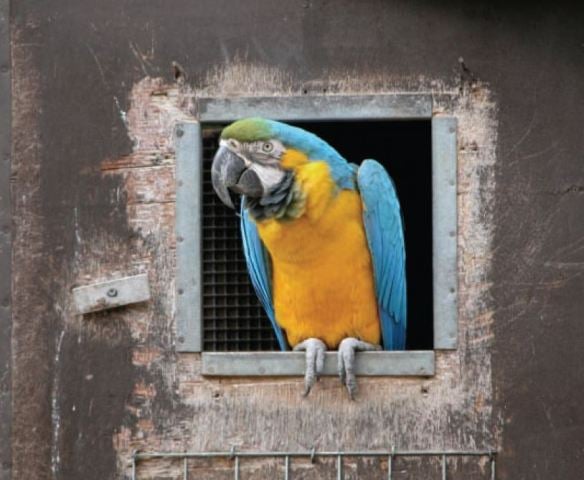
Our tendency to punish first, and ask questions later comes from our genetic understanding of the “alpha”. Human society, from its most fundamental beginnings, has always contained authority figures. In fact, this alpha being is seen in almost every living example of our closest relatives – primates. You could say that we are “hard-wired” to dominate, or be dominated by, other beings. This deeply ingrained programming prevents us from seeing the alternatives that an examination of other animal societies give us. When using dominance based training techniques with our birds, we need to ask ourselves “Does my bird understand dominance/submission?” Steve Martin, of Natural Encounters Inc. says on the subject of dominance in wild parrots, “I have talked to many parrot field researchers whose profession is studying parrots in the wild. None of these experts could recall ever seeing any form of hierarchy in the wild parrots…Also, none of the experts could recall ever seeing aggression for the sake of establishing dominance.”

The simple fact is that parrots in the wild may fight to gain or protect resources, but they don’t fight to establish a higher position in the flock. Why then, do we insist on using punishment and dominance whenever we encounter “opposition” in our parrots? Simply put, punishment is very rewarding to the punisher! Punishment can only be considered effective if it actually decreases the target behavior, but due to incorrect application, this rarely happens. Unfortunately, in rare cases, it does sometimes work. Owners will report that “when they shake their bird’s cage, the bird stops screaming, (for a short time). While doing nothing to actually eliminate the behavior (the bird still screams frequently), owners are reinforced by the temporary positive results. This occasional reinforcement, when coupled with the punisher’s inherent feelings of resentment and a subconscious desire for revenge, makes punishment a dangerously addictive training strategy.
A simple search into parrot training techniques reveals many time- honored traditions which, when examined closely, could be classified as punishment. Behavioral analysts define punishment as any consequence which, when coupled with a behavior, acts to decrease the likelihood that behavior will occur in the future. Let’s take a closer look at some of the common recommendations one hears when searching for advice when dealing with a difficult behavior problem:

We see time-outs take various forms with parrot training. Placing the bird back in the cage, turning off the lights, covering the cage, and relegating the bird to a far away room, are all examples of our attempts to apply Time-outs. These punishment methods assume that our bird’s only motivating factor is spending time out of his/her cage with us. Parrots are complicated emotional beings, and it is impossible to assume anything about their emotional states or motivations. If the bird is feeling tired, hungry, or nervous, going into their cage may be just what they actually want. Maybe our bird really does want our attention, and is acting out to get it. In this instance, running over to pick up the bird, even briefly, to put them back in the cage, would teach them that acting out is a way of getting attention. Parrots also live very much “in the moment”, and each behavior is either strengthened or weakened by the consequence immediately following it.
In order for time-outs to be effective training strategies, they must occur immediately after the behavior.
So much time is spent agonizing over what our birds shouldn’t do, that we don’t spend time training positive replacement behaviors. Teaching our bird to behave to gain rewards from us will provide a higher motivation to be good then they had to be bad.
We now get into a category of training techniques which involve the conscious decision to expose our birds to unpleasant and potentially trust-destroying stimuli. These techniques include: Squirting the bird in the face with a forceful stream of water, yelling or screaming at the bird, banging and shaking the cage, dropping the bird to the ground, and excessive “laddering”, flapping, and the “wobble correction”. All these depend on introducing an uncomfortable sensation that the bird will want to avoid in the future. Some of these techniques are still being touted as proper training methodology, but each one carries with it potentially unhealthy side-effects.
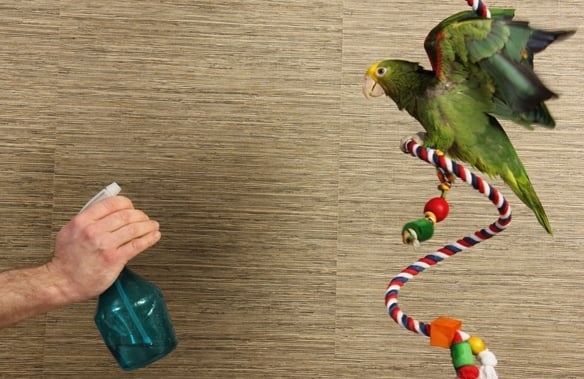
Squirting a bird in the face may teach a tropical bird to be terrified of bathing, leading to serious health problems. Yelling at your bird usually has the opposite effect, by giving the bird the classic drama reward (remember, parrots are loud, boisterous and outgoing creatures. When they see over-exaggerated responses from us, it is usually viewed as a wonderful game), and may actually cause an increase in the negative behavior. Dropping the bird to the ground is an aggressive act, and could result in the bird being afraid to step on the offered arm again, or even cause serious injury.
“Laddering”, flapping, and the “wobble correction” are all examples of “good training techniques gone bad”, when they are applied as discipline. Laddering is the act of having your bird step from one hand to the other, back and forth. Its purpose is to teach a reliable step-up response, and give the bird the opportunity to attain reinforcement for behaving well. This technique has also been put forth as a punishment for negative behavior, just as a drill sergeant may make a soldier do push-ups to make up for some transgression. It is said to “teach that bird that you are in charge”! In order for the association between action and punishment to be made by the bird, they have to be sitting on your arm at the time they misbehaved. It is no good to go running up to them to pick them up, as we have already concluded by examining drama rewards. If the bird is in an excitable mood when he is asked to ladder, he may be easily frustrated, and become more aggressive, not less. If we perform the action while annoyed or angry, our birds will read into this, and the anxiety/frustration the bird feels can be compounded.
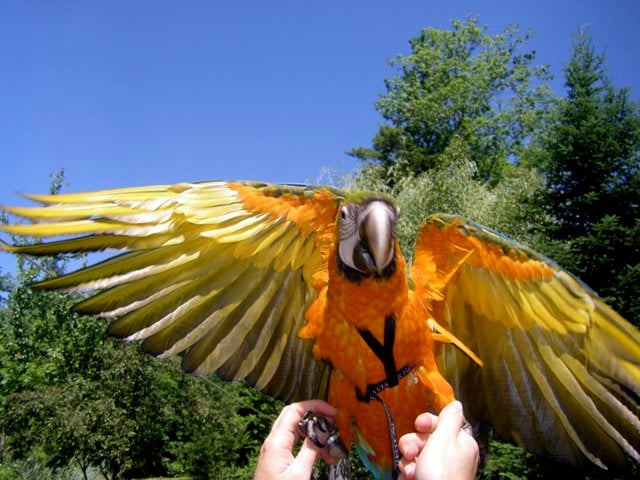
“Flapping exercises” are extremely important for all avian companions. Obesity due to inactivity is a serious concern with many parrots, and encouraging exercise is critical to their health and well being. Many birds are reluctant to do these exercises, and need to be trained to accept them. Exercise must always be positively reinforced. To use it as a punishment removes any motivation on the part of the parrot to perform this act by choice. The concept of “flapping the bird until he’s too tired to misbehave”, while doing nothing to teach proper behavior, will damage the relationship between parrot and parent, and can have serious effects on the birds physical and emotional health. Flapping exercises must always be done only to the birds activity tolerance level, must always be reinforced with various rewards, and must be done several times daily to promote optimum health.
A well exercised bird is more content, less prone to stress, and less likely to act out in a negative manner.
The “wobble technique” was designed to correct a baby parrot that is getting a little “beaky” while sitting on the owner’s hand/arm. The idea is that the arm is given a little shake to temporarily knock the bird off balance, thus breaking his concentration and making him forget all about biting. As a punishment technique, this is often taken too far, and the bird is violently shaken off balance (usually with verbal admonitions), sometimes falling to the floor. When we remember that most punishment techniques are applied out of a subconscious sense of revenge, we can see how easy it is to treat a hard bite to the arm by flinging the parrot to the ground. This action takes a split second to occur, but the trust destroyed can have long standing repercussions.
Without a doubt, we simply should never use pain to motivate our birds!
These techniques go beyond making the pet feel uncomfortable, and may actually cause pain. Flicking or grabbing a bird’s beak and shaking it, pulling out feathers, or even hitting the bird, all represent a relationship that has degraded to the point that rational thought no longer applies. These techniques are cruel and, rather than training a bird what he/she needs to learn to be a functional member of the household, sets up a viscous cycle of aggression and fear that is difficult to escape. Given what we now know of these remarkable creatures, it is hard to believe that some of these techniques can be found in books published as recently as 15 years ago. Parrots are only 2-3 generations removed from their wild counterparts, and have all their wild fight-or flight instincts intact. When these essentially wild animals convey the level of trust we know parrots are capable of giving, we are deeply honored. To intentionally inflict pain on these animals betrays that trust on the most fundamental level. Simply, we should never use pain to motivate our birds!!!
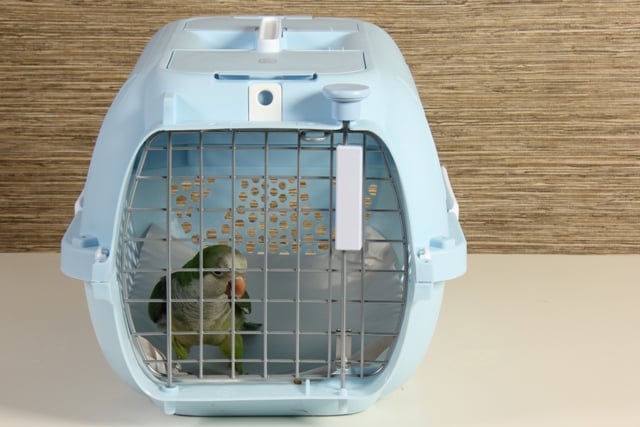
Sadly, this is all too often the final option selected by many pet owners. Every year, thousands of parrots end up in shelters and rescues, or are returned to breeders under the pretense that they will be happier somewhere else. While these owners rationalize their actions by saying there was nothing more they could do, these birds enter a very uncertain future with the heavy burden of years of emotional and behavioral baggage. They carry the negative behaviors that have been patterned in their first home, to every new situation they encounter. In Veterinary practice, it is a common occurrence to see birds that are living with their third, fourth, or even fifth owners. If allowed to raise their own young in a breeding situation, they can pass these behaviors on to their off-spring, setting up the next generation for potential failure. Parrots are too sensitive and intelligent to be bought, sold, and traded on a whim. It is important to accept our own responsibility for the problems seen in our parrots, and seek gentle alternatives with proven success rates to re-establish the connection we once had with our feathered companion.
In order for a punishment to work as a means of modifying behavior, it must meet very specific criteria. Steve Martin, of Natural Encounters, Inc., states “The timing of punishment is critical to its effect on behavior.” In order for the association to be made between act and consequence, the pet literally needs to be caught “in the act” at the first incidence of the negative behavior. Unfortunately, we often only discover our pet’s transgressions after the fact, or after several incidences of the pet getting away with the behavior. Any punishment applied in this instance only leads to confusion on the part of the pet, as to why they re being reprimanded. if your pet is caught red-handed (or red- beaked), the punishment would have to be severe enough to override the pets motivation for performing the act in the first place, thereby, decreasing the likelihood of it occurring again. All too often, we start by applying a mild scolding, but as our frustration grows, we escalate our efforts. At each step in this all-to-familiar sequence, our birds become desensitized to our methods. In this cycle, birds lack the opportunity to learn alternative reinforcement achieving behaviors. Eventually, we are trapped in a cycle of constant frustration and increasing hostility. Any trust we have established with our birds has been destroyed, and we begin to look at our companion as a burden instead of a blessing.
While remaining an inconsistent and difficult method of training due to our poor understanding and inappropriate application, punishment also carries many serious side-effects. According to Susan Friedman, PhD, “Research on the effects of aversive punishment is not new, nor has it been narrowly investigated. On the contrary, this research spans many decades and has been replicated with many different species of animals, including humans” *.
Researchers have identified four primary side effects of the application of aversive stimulus as modification tools:
Our once beloved companion may withdraw from any interaction with us, run or fly away at our approach, or even attack to avoid any negative stimulus. These unhappy souls may live in a constant state of anxiety, and the long-term consequences of this high- stress state can include feather-picking, self mutilation, stereotypes (excessively patterned movements, like tigers pacing in a zoo), and severe phobic behavior or aggression.
This is the question we need to ask ourselves before setting out a training program. Is the action I’m about to take going to build trust between my bird and I, or destroy it? By using this simple criterion to examine the above listed techniques, we can see the potential damage they can cause. The wonderful news is that there are alternatives!
ABA is the technique of examining a behavior in terms of the environmental elements that set the foundation for the behavior to occur (antecedent), the target behavior that needs modification (behavior), and the immediate result of the behavior (consequence). No behavior occurs in a vacuum. All behaviors are a result of environmental influences and reinforcement histories.
This simple equation, Antecedent=Behavior=Consequence, is the ABC of behavioral analysis. In order to modify a behavior, one must:
When identifying environmental triggers, it is important to remember the importance of immediacy.
When analyzing consequences, we must identify the reinforcer that caused the behavior to be repeated, and eliminate that element, while at the same time rewarding alternative more acceptable behaviors. Many people are so fixated on what they want their birds “not to do”, that they forget that birds can’t just sit still. They need to be given something to do instead of acting out. In order to eliminate negative behavior, these alternative behaviors need to have a greater reward value then what was attained by the negative behavior in the first place.
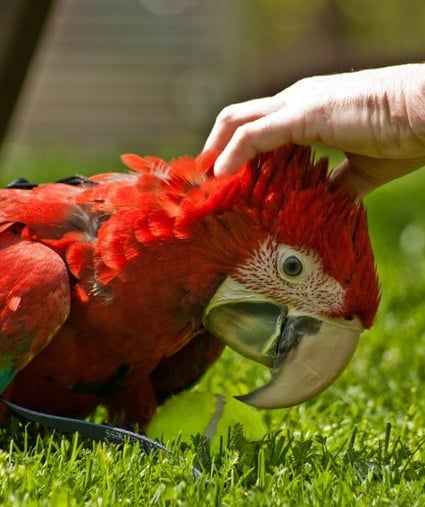
PRT is the most gentle and rewarding training method available. It works on capturing and strengthening good behavior through a variety of rewards. Although often dismissed as “bribery” training, we see countless examples of PRT in nature itself. A wild parrot that finds a tree laden with fruit will continue to return to that tree, but only until the fruit is exhausted. Once they receive no more reinforcement for their efforts, they return less and less often, until the behavior is extinguished (or the tree blooms again next year). Every living thing on the planet will naturally work to attain greater resources/mating opportunities, etc…In countless laboratory experiments, using a variety of species, from mice to primates, animals who were trained to work for rewards, continued to do so, even when given free access to another food supply. Reinforcement works that powerfully on our consciousness. This technique first gained wide acceptance in the 1960’s, when it was applied to marine mammal training. Dolphin trainers taught amazing, and sometimes highly unnatural behaviors (including the acceptance of sometimes uncomfortable veterinary procedures, without the use of anesthesia), using a wide array of rewards. Now this technique is used to train countless species around the world, but has only recently made its way into the world of companion animal training.
Given our sub-conscious drive to use dominance, coupled with the impact of splitting ear-drums, bruised skin, and hurt feelings, it is no surprise that these time-honored training traditions have become so entrenched in North American aviculture. Every parrot owner can close their eyes and think back to a time when their frustrations over- rode their best intentions for their birds. Recognizing this is the first step to making a real impact on the way we relate to our pets. Seeking out training methods which strive to develop and build upon the trust our birds convey on us is the next. Picture a relationship with your bird that is based on rewards and games. Picture your bird willing to do anything for your approval. Picture negative behaviors gradually fading into the past. It is our responsibility, as parrot parents and stewards of endangered species, to make the most of our relationship with them. It is one that is designed to last a lifetime.

By Kristi Flemming
References:
“Height Dominance” Steve Martin, Natural Encounters Inc., Psittacine Magazine, for the World Parrot Trust, 2001
“The Anatomy of Parrot Behavior” Steve Martin – Presented at the Association of Avian Trainers Conference Monterey, CA, August 2002
“Living and Learning with Parrots” – Lecture 6: Schedules of Reinforcement and Differential Reinforcement for Reducing Problem Behaviors” S. G. Friedman, Ph. D. 2004
“The Facts about Punishment” S. G. Friedman, Ph. D., Utah, and Bobbie Brinker, Ohio – Published in Original Flying Machine, Issue 4: Jan/Feb 2001
“Don’t Shoot the Dog: The New Art of Teaching and Training” Revised Edition. Karen Pryor Bantam Books, 1999
Kristi Flemming
Kristi has worked with exotic animals, ranging from hamsters to dolphins, for 14 years. She also has extensive experience as a parrot nursery manager and is currently working as head technician and avian behavior consultant at the Animal Hospital of High Park. Kristi is a professional member of the International Association of Avian Trainers and Educators (IAATE) and the World Parrot Trust (WPT).
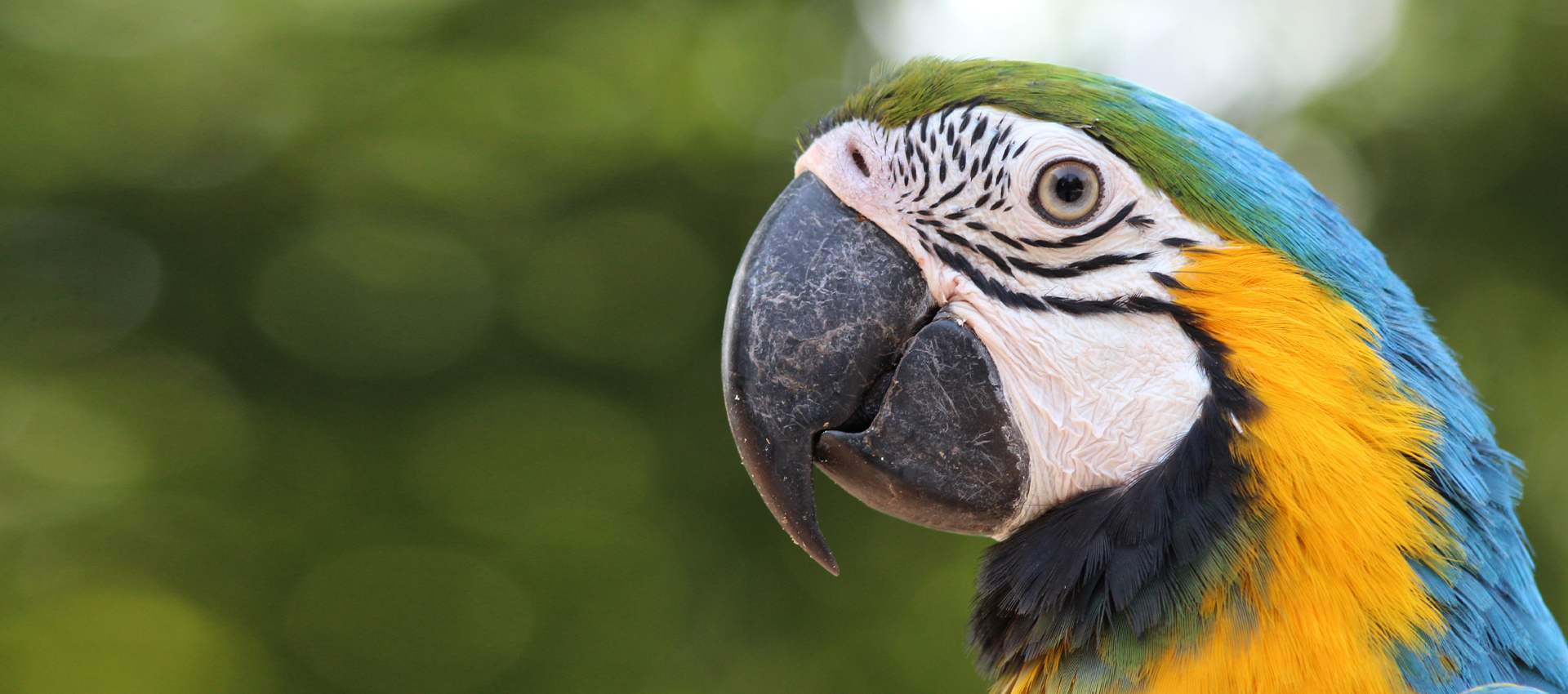
We’re here to help you with everything bird-related! Discover more about parrot conservation, browse conferences and events in your area, connect with local bird clubs, locate a vet or parrot rescue nearby, and read up on fascinating avian news and articles.